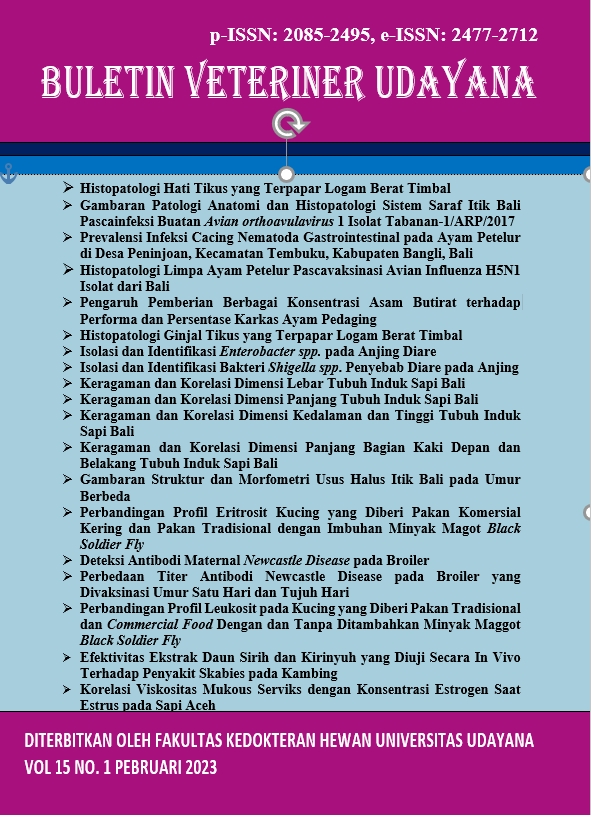DIVERSITY AND CORRELATION OF BODY WIDTH DIMENSIONS OF BALI CATTLE AT PUSAT PEMBIBITAN SAPI BALI UNGGUL, GEROKGAK, BULELENG, BALI
Abstract
Bali cattle are native Indonesian cattle as a result of the long-running domestication of wild banteng and are one of the germplasm that has the potential to be developed. This study aims to determine the diversity and correlation of body width dimensions of bali cattle. The samples used were 25 cows that were mature and had given birth. The data obtained were analyzed by descriptive analysis and biplot analysis and then presented in the form of tables and graphs. The results showed that the greatest coefficient of variation (various) was the width of the buttocks, which was 29.25%, followed by the neck width, which was 24.28%. chest width is 17.01%, cheek width is 13, 28%, steering width is 13.00% and the most uniform is head width 8.13%. While the correlation between the dimensions of the width obtained results that head width is positively correlated with cheek width and rudder width and is not correlated with chest width and neck width, but is negatively correlated with buttock width.
Downloads
References
Director General of Livestock Services. 2003. National report on animal genetic resources Indonesia. Directorate Generale of Livestock Services (DGLS), Directorate of Livestock Breeding. Indonesia.
Guntoro S. 2002. Membudidayakan sapi bali. Penerbit Kanisius Yogyakarta.
Kadarsih S. 2003. Peranan ukuran tubuh terhadap bobot badan sapi bali di Propinsi Bengkulu. J. Penelitian UNIB. 9(1): 45-48.
Matjik AA, Sumertajaya IM. 2011. Sidik peubah ganda: dengan menggunakan SAS, IPB press, Bogor.
Martojo H. 2003. Indigenous bali cattle: the best suited cattle breed for sustainable small farms in Indonesia. Laboratory of Animal Breeding and Genetics, Faculty of Animal Science, Bogor Agricultural University, Indonesia.
Salamena JF, Noor RR, Sumantri C, Inounu I. 2007. Hubungan genetik, ukuran populasi efektif dan laju silang dalam per generasi populasi domba di Pulau Kisar. J. Indon. Trop. Anim. Agric. 32(2): 71-75.
Sampurna IP, Suatha IK. 2010. Pertumbuhan alometri dimensi panjang dan lingkar tubuh sapi bali jantan. J. Vet. 11(1): 46-51.
Sampurna IP, Saka IK, Oka GL, Sentana P. (2014). Patterns of growth of Bali cattle body dimensions. ARPN J. Sci. Technol. 4(1): 20-30.
Suliyanto. (2005). Analisis data dalam aplikasi pemasaran. Bogor: Ghalia Indonesia.
Prihandini PW, Hakim L, Nurgiartiningsih VMA. 2012. Seleki pejantan berdasarkan nilai pemuliaan pada sapi ongole (PO) di loka penelitian sapi potong Grati-Pasuruan. J. Ternak Trop. 13(1): 9-18.
Puspitasari DR, Ardika IN, Sukmawati NMS. 2018. Variasi ukuran tubuh dan bobot badan sapi bali jantan pada umur 8 bulan di Balai Pembibitan Ternak Unggul dan Hijauan Pakan Ternak Denpasar. J. Trop. Anim. Sci. 6(1): 83-89.
Takandjandji M, Sawitri R. (2015). Ukuran morfometrik banteng (bos javanicus d’alton, 1823) untuk menduga bobot badan. J. Penelitian Hutan dan Konservasi Alam. 12(1): 59-73.
Tillman AD, Hartadi H, Reksohadiprodjo S, Prawirokusumo S, Lebdosoekojo S. 1991. Ilmu makanan ternak dasar. Cetakan ke-5. Gajah Mada University Press, Yogyakarta.
Trisnawanto T, Adiwinarti R, Dilaga WS. (2012). Hubungan antara ukuran-ukuran tubuh dengan bobot badan Dombos jantan. Anim. Agric. J. 1(1): 653-668.





